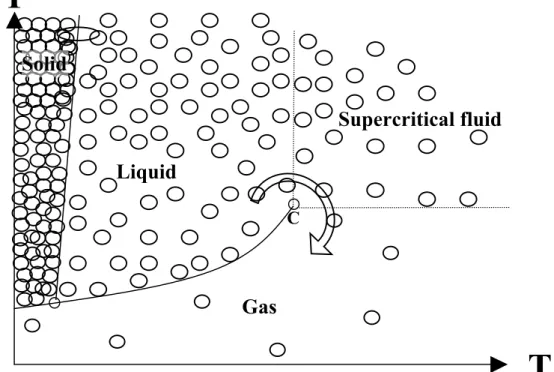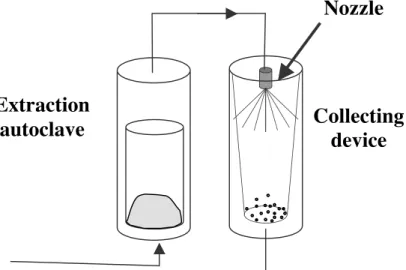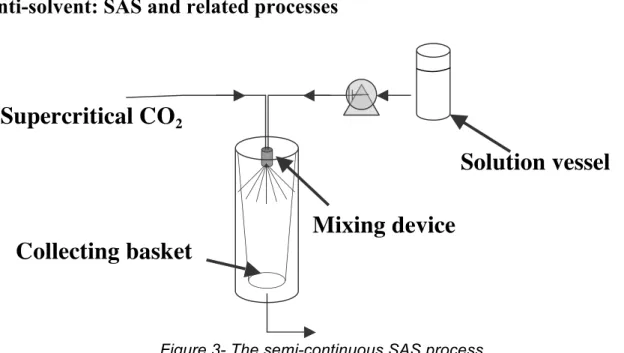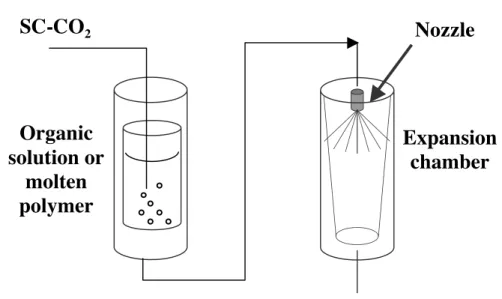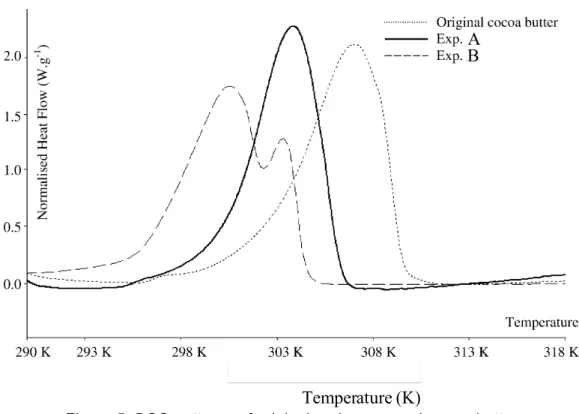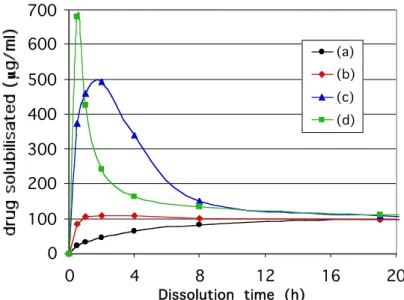HAL Id: hal-01781676
https://hal.archives-ouvertes.fr/hal-01781676
Submitted on 13 Aug 2019HAL is a multi-disciplinary open access
archive for the deposit and dissemination of sci-entific research documents, whether they are pub-lished or not. The documents may come from teaching and research institutions in France or abroad, or from public or private research centers.
L’archive ouverte pluridisciplinaire HAL, est destinée au dépôt et à la diffusion de documents scientifiques de niveau recherche, publiés ou non, émanant des établissements d’enseignement et de recherche français ou étrangers, des laboratoires publics ou privés.
Supercritical carbon dioxide : an efficient tool for the
production of ultra-fine particles for the food and
pharmaceutical industries
Jacques Fages, Martial Sauceau, Jean-jacques Letourneau, Élisabeth Rodier
To cite this version:
Jacques Fages, Martial Sauceau, Jean-jacques Letourneau, Élisabeth Rodier. Supercritical carbon dioxide : an efficient tool for the production of ultra-fine particles for the food and pharmaceutical industries. NEPTIS-13 -13th Nisshin Engineering Particle Technology International Seminar, Nov 2004, Awaji, Japan. p.29-39. �hal-01781676�
Supercritical carbon dioxide : an efficient tool for the production of ultra-fine particles for the food and the pharmaceutical industries
Jacques FAGES,
Martial SAUCEAU, Jean-Jacques LETOURNEAU and Elisabeth RODIER Ecole des Mines d'Albi, Chemical Engineering Laboratory for Particulate Solids,
UMR-CNRS 2392, Campus Jarlard, 81013 ALBI, FRANCE E-mail : Jacques.Fages@enstimac.fr
Abstract
The agro-food, pharmaceutical, cosmetics and detergent industries are among the greatest users of particulate solids, or powders. It is hardly necessary, therefore, to expound their industrial importance. However, there is still plenty of room for development, as their generation, their formulation and the control of their usage properties are yet to be fully mastered.
In the domain of particle formation, there are traditionally two main ways of obtaining
divided solids, depending on whether the base material is in the solid or liquid state: crushing, milling, comminution belong to the former category while crystallisation, precipitation, spray-drying and atomization belong to the latter.
Obtaining powders by processes using supercritical fluids is a third route, which has
undergone significant development during the last decade. By using pressure as an operating parameter, these processes lead to the production of fine and monodisperse powders. There exist three families of processes (RESS, SAS and PGSS) according to the way in which the FSC - generally CO2 - is used.
• In the RESS process, CO2 is the solvent and it is the fall of density related to a rapid depressurisation which promotes the nucleation of the solute. Although it is easy to implement, this process is however limited by the relatively tight spectrum of CO2 -solvent properties.
• In the SAS process, CO2 is used as a non (or anti)-solvent and it is the reciprocal dissolution of an organic solution and the supercritical fluid which causes
precipitation. The great versatility of SAS remains its principal advantage. • Lastly, in the PGSS process, the dissolution of CO2 into an organic solution or a
molten polymer, is followed by an abrupt depressurisation in which the dissolved gas acts as an aerosol generator helping the particle formation. This process is particularly advisable for polymer coating applications.
In this paper, two examples of application of these processes are described.
A high-value foodstuff, cocoa butter has been crystallised in a specific polymorph. The particles produced can be used to improve tempering, a key-stage in the chocolate manufacturing process.
Secondly, a hypocholesterolemic drug, eflucimibe, has been processed. A new process using three different steps has allowed a significant improvement in dissolution rate and oral bioavailability.
Introduction: supercritical technology, a new route for the formation of
ultrafine powders
As shown on the phase diagram (figure 1), supercritical fluids (SCF) are defined as being compounds placed simultaneously at a pressure and a temperature higher than those of their critical point.
Figure 1 – Phase diagram of a pure substance
They present properties (density, viscosity, mass transfer) intermediate between those of the liquids and gases. The other major characteristic of these fluids is that one can vary their properties in broad proportions by tuning pressure, a very convenient operating parameter. SCF are at the same time dense and compressible. These properties are at the origin of the discovery that it is possible to generate finely divided solids by abruptly depressurising a supercritical solution.
Among the usable compounds, carbon dioxide (CO2), is the far most widely used
supercritical fluid. Its Pc and Tc are relatively easy to reach. Its solvent power is relatively close to those of chlorinated solvents (CHCl3, CH2Cl2, CFC’s) and normal alkanes like hexane
which are already or might soon be banned. Nevertheless, CO2 is a rather poor solvent for
polar molecules. However, CO2 can also solubilise highly polar compounds provided
adequate CO2-soluble surfactants (like fluoro-ethers) are used.
In addition, it exhibits several other advantages: it is natural, cheap, easily available, gaseous at atmospheric pressure, non toxic and non corrosive. It is recycled from the fertiliser industry (it comes from the environment and will return to it after use) and therefore, in this way, does not add to the greenhouse effect.
Since the middle of the eighties, an intense activity of research has been developed which strongly intensified in the nineties. Several processes of elaboration and design of particulate
Gas
CP
T
Supercritical fluid
Liquid
Solid
solids have been set up. They avoid the majority of the disadvantages of the traditional powder generation processes and have important specific advantages:
• Production of ultra-fine powders, with a tight particle size distribution:
The smaller the particles, the more the surface properties will override the volume properties. For example, the kinetics of dissolution of a powder depends directly on the particle size. A tightened distribution will ensure a reduced variability which is one of the key factors for a successful industrialization of a process.
• Production of composite particles:
The microencapsulation and the coating of an active substance by a protective agent are techniques sought in many industrial sectors whose products require a protection or when a differed effect is desired.
Pharmacy, cosmetics, agrochemicals, inks and paintings industries, are large users of these composite particles.
• Control of crystal polymorphism:
Undergoing crystallization, the molecules fit together according to an ordered structure. For complex organic molecules, it is frequent that there are several manners for the molecules of ordering in the crystal in formation, leading to the so-called polymorphs. Two polymorphs are two different substances, which can have different properties. Each polymorph will have a different thermodynamic stability, but the kinetics can lead first to a polymorph which is not the most thermodynamically stable. To obtain the desired form in a reproducible way is therefore a matter of concern. The fast and single-step supercritical processes often make it possible to control crystal polymorphism.
In this paper we will introduce the main supercritical particle generation processes followed by a brief presentation of two examples from our experience in the domains of the food and pharmaceutical engineering.
The three categories of particle generation process:
RESS and related processes
Figure 2 – The RESS process
Collecting
device
Extraction
autoclave
The RESS process consists in a dissolution-recrystallization. As shown on figure 2, the solid of interest is dissolved in the FSC before being re-cristallised by an abrupt depressurisation through an expansion device. In the supercritical domain, a fluid is both dense and compressible. The density, connected to the solvent capacity will vary in great proportions, according to the conditions of temperature (T) and pressure (P). The great and sudden fall of pressure, accompanied by a simultaneous fall of the temperature, causes huge supersaturation ratio and the nucleation of crystals. Co-precipitation of two compounds is also possible provided they are both soluble in the SCF. For industrial applications, it is necessary to recycle the fluid. A pressure of a few MPa is therefore maintained in the expansion vessel. The depressurisation must however be sufficient to obtain a great fall of solubility, in spite of the reduction of supersaturation.
Anti-solvent: SAS and related processes
Figure 3- The semi-continuous SAS process
When the solute is insufficiently soluble in the FSC, the latter can be used as anti-solvent. This is the rationale of the SAS process (Supercritical Anti Solvent) which is particularly adapted for molecules known for their very low solubility in supercritical CO2, such as sugars, proteins, polymers or metallic oxides. In addition to the compound to be micronised and the FSC, an organic solvent is necessary which must present at least the three following properties:
- to be a good solvent of the studied compound;
- to have a good compatibility with the anti-solvent. Ideally, they must even be completely miscible;
- to leave the minimum residues in the solid crystallized at the end of the process.
A semi-continuous operating mode is most often used (see figure 3): the contact of the solution (solute + organic solvent) with the supercritical anti-solvent occurs at the nozzle level. The supercritical fluid dissolves in the organic phase decreasing its density, and thus the solubility of the solute. At the same time, the solvent will evaporate in the supercritical phase, increasing the concentration of the solute. It is this bidirectional mass transfer which explains the rapid supersaturation leading to the solute nucleation.
Supercritical CO
2Mixing device
Collecting basket
Except for the recovery of the particles, the remainder of the process can be operated continuously. The solvent can be recovered in separators downstream, while the anti-solvent can be recycled by compression and heating. A stage of washing or extraction with pure CO2 is recommended at the end of the process, in order to eliminate the last solvent traces which could remain within the crystallized particles.
Solute: PGSS and related processes
Figure 4- The PGSS process
PGSS means "Particle from Gas Saturated Solutions". A gas under pressure can be solubilised in a liquid in large quantity: it is this property which is used here. A dense gas, generally CO2, is dissolved in a liquid in a first autoclave. This liquid can be a solution, a suspension or a molten polymer. The solution saturated with gas thus obtained is sent in an expansion vessel through a tube (see figure 4). The generation of particles takes place at the time of the drop in pressure and temperature and the formed particles are then recovered in the autoclave of expansion. In this process, CO2 can also act as an activator of aerosolisation.
This process was developed at first for polymers in which great quantities of CO2 can be dissolved. This dissolution is accompanied by a depression in the glass transition and melting temperatures, and by the swelling and the plasticization of polymer. If a third component is previously dissolved or suspended in the polymer, the final depressurisation may lead to micro-spheres of polymer with an embedded substance.
Moreover, CO2 reduces viscosity considerably, which will facilitate the handling of these solutions/suspensions.
Expansion
chamber
Nozzle
SC-CO
2Organic
solution or
molten
polymer
An example for the food industry: crystallisation of cocoa butter for
improving the tempering step of the chocolate manufacturing process
Cocoa butter (CB), the fat of chocolate, is a complex mixture of triacylglycerol (TAGs), which melting points are in the “good” range to give the pleasant “melt in the mouth” sensation. The most abundant are monounsaturated TAGs, the unsaturated fatty acid (very often oleic acid) being in the 2-position. 1-palmitoyl-2-oleyl-3stearoylglycerol (POS) ; P-O-P and S-O-S account for 36-38 %, 14-16 % and 23-28 % respectively of the total TAGs. There are six different ways for the TAGs to arrange themselves when they crystallise. Six different polymorphs noted I (the less stable with the lowest melting point 290 K) to VI (the most stable with the highest melting point 307 K) can be obtained. The relative amount of these six polymorphs will condition several features of the end product. If the wrong type of fat is present the chocolate may exhibit a white powdery surface called fat bloom which is to be avoided because of its unpleasant appearance. The most desirable form is known as form V (or β2) having a melting temperature of 305-307 K. Form V is hard with a good snap and a glossy appearance and good resistance to bloom. The even more stable form VI is not desirable since it might lead to fat bloom as do the less stable forms. Form VI is only formed by solid-solid transformation and not directly from liquid cocoa butter. Chocolate with fat in form V may start to bloom after a period of months or even years [2].
To obtain predominantly form V a pre-crystallisation step also called tempering has been introduced in the chocolate manufacturing process. It is aimed at the formation of form V seed crystals (1 to 3 % of the total fat content), which in turn will force the bulk of the remaining fat to crystallise in this stable form.
Two main operating routes are possible:
§ starting with hot liquid chocolate (318 – 323 K) a succession of cooling to 300 K in order to form both stable and unstable crystals followed by re-heating to 303-305 K to melt only less stable crystals will lead to some form V crystals which, in turn, will seed the mass of chocolate.
§ seeding the mass of untempered chocolate by finely divided form V crystals of cocoa butter. This is usually carried out at 303 K. A mass fraction of 0.5% to 2% of ordinary cocoa butter seeds is mixed with the melted chocolate.
Experimental set up and configurations
a) production of particles
We have developed a RESS-derived process aimed at the production of fine formV cocoa butter crystals for tempering chocolate by seeding. The experiments were carried out in a stirred autoclave (Parr, USA) for the extraction coupled to a versatile pilot plant (Separex, France).
The saturated mixture (CO2 + CB) sprayed into the expansion vessel via the nozzle (fig. 2), is subjected to a sudden drop in pressure, resulting in supersaturated conditions and the
crystallisation of the cocoa butter. This powder is collected in the bag inside the second vessel. Detailed experimental procedure can be found elsewhere [3].
Two major types of experiments have been achieved:
§ In the first one, the first vessel is let to slowly depressurise during its emptying through the nozzle. Therefore, particles of cocoa butter can also be formed in this vessel. The powders thus obtained were generally white, extremely light and
§ In the second, the pump feeds the vessel with CO2 in order to compensate the
emptying via the nozzle and to maintain a constant pressure. Powders collected in the bag of the expansion vessel were white, light, free-flowing with regular individual particles. The yield is directly correlated with the ΔP applied at the nozzle.
b) tempering experiments
Tempering experiments were performed using a computerised tempermeter. The degree of pre-crystallisation can be evaluated by the following procedure:
The pre-crystallised chocolate sample is put in a special container and placed in the instrument cell at 281 K. A cooling curve in which the change in temperature is plotted against the time. In a typical tempering curve, the exothermic process of crystallisation generates an inflexion point. The slope at this point is used to determine if the chocolate is under-, well- or over-tempered. A well-tempered curve shows an horizontal plateau.
Main results
a) characterization of the particles
Figure 5. DSC patterns of original and processed cocoa butter
Figure 5 shows the DSC curves of original cocoa butter, compared with a powder obtained in the expansion vessel (sample A) and a powder collected in the extraction autoclave (sample B).
Original cocoa butter was in form VI. Powder A characteristics (ΔHfus = 120.3 J.g-1; T melt = 304 K) are typical of form V. The particles obtained were made of an agglomeration of smaller particles For powder B, the two peaks are characteristic of both form IV and V. More geometric shaped particles were obtained in this case.
Temperature (K) Fig. 3. Typical DSC curves.
The powder obtained in experiment 5 was collected in the vessel (5) and has the following characteristics: Tpeak
= 300.5 K, Tend-set = 302.5 K for the first peak and: Tpeak
= 303.7 K, Tend-set = 305.0 K for the second peak. All the
Fig. 4. ESEM picture of a cocoa butter particle obtained with experiment #15.
particles obtained in this vessel are made of a mixture of both forms IV and V. The faster the drop in pressure in this vessel, the larger the quantity of form V powder obtained. A typical example of this kind of particle is shown in Fig. 5. This
B A
b) tempering experiments
Experiments were performed with a type A powder. The angular shape of these agglomerates may favour the seeding process.
At 304 K - the usual temperature- and below, the chocolate was quickly over-tempered showing great potential for this powder.
At 306 K and above, the seeding produced an under-tempered chocolate.
A well-tempered chocolate was obtained at 305 K (32ºC), with a mass fraction of cocoa butter seeds of 0.1-0.2%.
“Supercritically-produced “ CB powder allows to seed liquid chocolate 2 K higher than common seeding and several degrees higher than most industrial temperers. Therefore, the chocolate is very much thinner and easier to handle because of its lower viscosity.
In addition, the mass fraction used is at least 3-5 times lower than the classical quantity used. Time necessary to insure tempering is also much smaller than in the classical process
The DSC measurements made on the final product showed that the whole mass of the fat has crystallised in form V. When an important overtempering or a very long duration was
observed, some form VI crystals can be formed.
In summary, this new process shows great promises for producing seeds extremely efficient for chocolate tempering. By comparison with the classical seed tempering process, it allows to work:
•
at higher temperature (305 K), the chocolate being less viscous which is advantageous in term of flowability and energy consumption.•
with less cocoa butter ( 0.1-0.2 %)•
quicker (about 5 minutes).An example for the pharmaceutical industry: improving the bioavailability of
an active pharmaceutical drug
The lack of bioavailability is one of the major actual problems of the pharmaceutical industry. A large number of new drugs are almost insoluble in the biological fluids leading to a reduced bioavailability. Improving their dissolution rate is therefore a goal for researchers. Various methods can be used to increase the dissolution rate like size reduction by comminution leading to finely divided powder or complexation with cyclodextrins. Cyclodextrins are cyclic oligosaccharides which can form inclusion complex with large organic molecules. The resulting complex may improve the stability, solubility and bio-availability of the host molecule. The most used techniques for achieving inclusion imply either an aqueous solution or a process in solid state like grinding or kneading [5].
Supercritical carbon dioxide has recently appeared as an efficient complexation medium for the preparation of inclusion complexes using its favourable transport properties. Depending on the solubility of the host molecule different techniques can be applied: Extraction and percolation through a cyclodextrin packed bed, co-crystallisation by SAS process or complexation using a static method.
Eflucimibe is an active compound (M = 469,73 g.mol-1
) provided by the Pierre Fabre company and poorly soluble in supercritical CO2 (5.71 10
-7
mol/mol at 274 bars and 308 K) [4]. It was therefore a good candidate to be processed by an anti-solvent method. We have
developed a new process coupling an anti-solvent crystallisation of this drug with an inclusion in γ-cyclodextrin. It is composed of three consecutive steps, a co-crystallisation of both components by SAS, a batch step leaving the powder in a supercritical CO2 medium and
finally a solvent stripping step.
Experimental set up and configurations
The experiments were carried out in a versatile pilot plant (Separex, France).
For the SAS experiments (fig. 3), the solvent used was DMSO and the antisolvent was CO2. Both compounds, γ-cyclodextrin, and eflucimibe were dissolved in DMSO. The
solution was injected by an HPLC pump into the CO2 stream.
The organic solution and the anti-solvent were contacted in the mixing chamber of a nozzle and the resulting mixture was sprayed into the expansion vessel. The powder formed was collected in a porous bag. Then, CO2-solvent mixture was depressurised and separated in
cyclonic separators.
For the batch step configuration, 2.33 g of water were added to 7g of eflucimibe/cyclodextrin powder and placed in an autoclave. This vessel is then filled with supercritical CO2 at the desired pressure and temperature and left during several hours. To
finish this step, the vessel is slowly depressurised and the powder taken away.
During the solvent stripping step performed in the same autoclave, supercritical CO2
flowing through a stainless steel basket containing the organic compound during two hours. Dissolution tests were performed at 37°C. A mass of powder containing 100 mg of eflucimibe was put in 100 ml of aqueous solution containing sodium-dodecyl-sulfate, SDS (5% m/v). Periodically, 2 ml of solution were sampled and the concentration of dissolved drug was measured by HPLC.
Main results
a) The co-crystallisation process ensures a good and fine dispersion of the hydrophobic drug in the hydrophilic matrix of cyclodextrin. Moreover, a part of eflucimibe contained in the mixture after co-crystallisation was not visible by DSC suggesting the formation of an amorphous or microcrystalline form. The study of the influence of mass ratio of CO2 to DMSO, varying between 50 and 300, on the composition and dissolution rate of the resulting powder revealed that this parameter had no effect. On the contrary, decreasing the molar ratio of eflucimibe to cyclodextrin in the initial mixture from 1/1 to 1/3 increased the drug yield in the resulting powder from 40% (w/w) to 70 % (w/w). The cyclodextrin may exert a stabilising effect on eflucimibe. After this step, the dissolution rate was increased in the first hours by comparison with the physical mixture with the same profile (Figure 6). In summary, co-crystallisation by SAS ensures a very fine and homogeneous dispersion of the hydrophobic drug among the hydrophilic CD powder.
b) The second batch step, in presence of water, was carried out under supercritical conditions for a few hours, leading to a solid dispersion with an enhanced dissolution rate. This formation is favoured by the good mass transfer properties of supercritical CO2. The role of
water is probably a plasticizing agent enhancing the dispersion degree between both eflucimibe and CD. In addition, water is a solvent for the mixture, which partially dissolves and recrystallises in other places, enhancing the dispersion of eflucimibe into CD. A strong modification of the drug dissolution profile can be observed with a peak having a maximum value as high as 500µg/ml (Figure 6).
c) Finally, the stripping step extracts the residual solvent. The main drawback of this step is the simultaneous extraction of some active substance. On the dissolution rate the effect is even more pronounced with a much sharper and higher dissolution peak (figure 6)
Figure 6 - Dissolution curve of physical mixture (a); co-crystallised powder (b); powder after co-crystallisation and static batch step (c); powder after co-crystallisation, static batch
step and stripping (d)
To explain the shapes of the dissolution curves we suggest the formation of a solid dispersion instead of a true inclusion complex. This hypothesis has been proposed based on more detailed analyses not presented here.
First, the dissolving medium diffuses into the CD matrix containing eflucimibe. Then, eflucimibe is dispersed into the dissolving medium and is temporary stabilized into SDS micelles; this corresponds to the maximum of the peaks. Finally, a recrystallisation of eflucimibe occurs leading back, to the solubility of neat eflucimibe in this dissolving medium, that is around 100µg/ml. Finally, the acceleration of the dissolution kinetics after the stripping step may be due to the acceleration and amplification of the first dissolution step, that is the diffusion of the aqueous medium through the dehydrated CD matrix.
Finally, an in vivo bio-availability assay on dogs has been performed showing a 11-fold increase in bio-availability giving a clear confirmation of the interest of this new process. References
1. Fages, J., Lochard, H., Letourneau, J.-J., Sauceau, M., Rodier, E., (2004). Particle generation for pharmaceutical applications using supercritical fluid technology. Powder Technology. 141 : 219-226.
2. Beckett, S.T. (2000). The science of chocolate, RSC paperbacks.
3. Letourneau, J.-J., Vigneau, S., Gonus, P., Fages J., (2005). Micronized cocoa butter particles produced by a supercritical process. Chemical Engineering and Processing. 44, 201-207. 0 100 200 300 400 500 600 700 0 4 8 12 16 20 Dissolution time (h) (a) (b) (c) (d)
4. Sauceau, M., Letourneau, J.-J., Freiss, B., Richon, D., Fages, J., ( 2004). Solubility of eflucimibe in supercritical carbon dioxide with or without a co-solvent. Journal of Supercritical Fluids. 31, 133-140.
5. Gil, A., Chamayou, A., Leverd, E., Bougaret, J., Baron, M., Couarraze G., (2004). Evolution of the interaction of a new chemical entity, eflucimibe with γ-cyclodextrin during kneading process, European Journal of Pharmaceutical Sciences. 23, 123-129.
